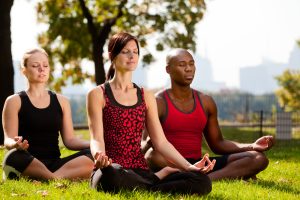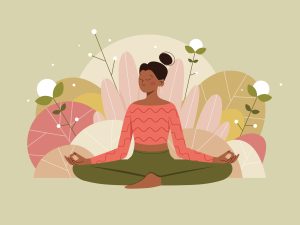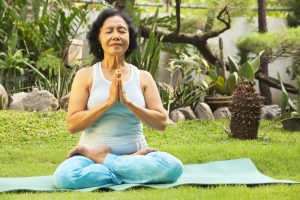By – James M. Katz, BA
Meditation has become increasingly popular as people seek ways to reduce stress and improve their overall well-being. Learning from a certified Meditation Instructor can help us learn the different types of meditation practices and the unique benefits they offer, allowing individuals to find techniques that resonate with their personal goals and preferences. From breath awareness to mindfulness meditation, the variety of approaches caters to diverse needs and lifestyles.
This article explores several meditation styles, including guided meditation, focused attention, open monitoring, loving-kindness, and body scan techniques. By understanding these different methods of meditation, readers can discover which practices align with their objectives and start their journey toward inner calm and self-discovery. Whether one aims to sharpen focus, cultivate compassion, or deepen body awareness, there’s a meditation type to suit every purpose.
Certified Meditation Instructor – Guided Meditation: A Beginner’s Gateway
Guided meditation serves as an excellent starting point for those new to meditation practices. This approach involves following the instructions of a meditation teacher, either in person or through audio recordings. It provides a structured framework that helps beginners navigate the often-challenging process of quieting the mind and focusing attention.

Benefits of guided meditation for newcomers
For those just beginning their meditation journey, guided sessions offer numerous advantages. They provide a clear path to follow, reducing the uncertainty that can often accompany solo meditation attempts. This structure helps newcomers feel more confident and comfortable as they explore different types of meditation practices.
One of the primary benefits of guided meditation is its ability to reduce stress and promote relaxation. Research has shown that as little as 12 minutes of daily meditation over an eight weeks can lead to noticeable changes in the brain, decrease anxiety levels, and increase overall well-being. This makes guided meditation an effective tool for managing stress in today’s busy world.
Moreover, guided meditation with a certified meditation instructor can help improve focus and concentration. By following the instructor’s voice, practitioners learn to direct their attention more effectively, a skill that can be applied in various aspects of daily life. This enhanced focus can lead to increased productivity and a greater sense of calm throughout the day.
Types of guided meditations
There are various types of guided meditations, each designed to address specific needs or goals. Some common forms include:
1. Mindfulness meditation: This practice focuses on developing non-judgmental awareness of the present moment, often by paying attention to breath or bodily sensations.
2. Loving-kindness meditation: This technique aims to cultivate compassion and positive emotions towards oneself and others.
3. Body scan meditation: This practice involves systematically focusing attention on different parts of the body, promoting relaxation and body awareness.
4. Visualization meditation: This type uses imagery to evoke specific mental states or emotions, such as imagining a peaceful natural setting.
5. Mantra meditation: This form involves repeating a word or phrase to focus the mind and create a sense of calm.
Each of these meditation styles offers unique benefits, allowing individuals to choose the approach that resonates most with their personal goals and preferences.
Resources for finding quality guided sessions
For those interested in exploring guided meditation, numerous resources are available. Finding a certified meditation instructor is easy! Many meditation apps, such as Headspace and Calm, offer a wide range of guided sessions led by experienced teachers. These apps can be particularly helpful for beginners, providing structured programs and the flexibility to meditate anytime, anywhere.
Online platforms like YouTube also host a wealth of free guided meditation videos. Channels run by certified meditation instructor such as The Honest Guys and Michael Sealey offer a variety of sessions tailored to different needs, from stress relief to improved sleep. For those seeking a more personalized experience, local meditation centers or yoga studios often provide guided group sessions led by trained instructors. These in-person classes can offer the added benefit of community support and the opportunity to ask questions directly to a teacher. Podcasts are another excellent resource for guided meditations. Shows like Tara Brach’s weekly meditation podcast combine teachings on mindfulness with guided practice sessions, offering both instruction and practical experience. By exploring these various resources, beginners can find the guided meditation style and format that works best for them, setting the foundation for a rewarding and sustainable meditation practice.
Focused Attention Meditation: Sharpening the Mind
Focused attention meditation (FAM) is a powerful technique among the different types of meditation practices that aims to enhance concentration and mental clarity. This method involves directing one’s attention to a specific object, thought, or sensation, training the mind to maintain focus and resist distractions.
Techniques for developing concentration
One of the most common certified meditation instructor techniques in focused attention meditation is mindful breathing. This practice involves concentrating on the natural rhythm of one’s breath, observing the sensation of air entering and leaving the nostrils or the rise and fall of the chest. By shifting focus away from distracting thoughts, this technique can offer stress relief and improve one’s ability to concentrate on tasks requiring sustained mental effort.
Another effective technique is counting breath cycles. This method involves counting each exhale up to a certain number before starting back at one. This simple yet dynamic task can help maintain focus on the breath and prevent the mind from wandering, thereby strengthening concentration skills. For those new to meditation, guided sessions can be particularly helpful. These involve following the instructions of a meditation teacher, either in person or through audio recordings. Guided meditations provide structure and can help practitioners discover new techniques while deepening their understanding of meditation.
Using objects of focus (breath, image, phrase)
While the breath is a common focal point in focused attention meditation, practitioners can choose from a variety of objects to concentrate on. Some may prefer to focus on a physical item, taking advantage of our natural tendency to direct attention toward objects in front of us. This object-focused meditation allows individuals to anchor their attention and train their minds to be fully present in the moment.
Alternatively, practitioners might use a specific phrase or mantra as their point of focus. Mantra meditation, as taught by a certified meditation instructor, involves repeating a word or phrase to center the mind and create a sense of calm. This technique can be particularly effective for those who find it challenging to concentrate on physical sensations. Visual meditation is another variation of focused attention practice. This involves directing attention to a specific image or visualization, such as imagining a peaceful natural setting. By engaging multiple senses in the experience, visual meditation can help practitioners immerse themselves fully in the present moment.
Benefits for cognitive function and mental clarity
Research has shown that focused attention meditation can have significant benefits for cognitive function and mental clarity. Studies suggest that this practice can improve attentional control, making it easier to maintain focus and recover from distractions.
Moreover, focused attention meditation has been found to reduce activity in areas of the brain associated with mind-wandering. This can help practitioners stay more present and focused on their current tasks. The practice has also been linked to improvements in convergent thinking – the ability to come up with a specific solution to a well-defined problem. This enhanced problem-solving capability can be particularly beneficial in various aspects of daily life.
Regular practice of focused attention meditation can lead to increased gray matter density in areas of the brain responsible for information processing, learning, and memory. This structural change can contribute to improved cognitive functions, including enhanced memory, attention, and decision-making skills.
In conclusion from a certified meditation instructor point of view, focused attention meditation offers a practical and effective way to sharpen the mind, improve concentration, and enhance overall cognitive function. By consistently practicing these techniques and exploring different objects of focus, individuals can develop a stronger ability to maintain attention and achieve greater mental clarity in their daily lives.
Open Monitoring Meditation: Expanding Awareness
Open monitoring meditation (OMM) is a unique approach among different types of meditation practices that focuses on cultivating a broad, receptive awareness of all experiences arising in the present moment. Unlike focused attention meditation, which directs concentration to a specific object, OMM encourages practitioners to remain open to whatever emerges in their field of consciousness without judgment or attachment.
Principles of non-directive meditation
Non-directive meditation techniques, including open monitoring meditation, are characterized by a relaxed focus that allows thoughts, images, sensations, memories, and emotions to flow freely without expectation or control. This approach is believed to facilitate the processing of emotional experiences, contributing to overall wellness and stress management. In OMM, practitioners maintain a non-reactive and non-judgmental awareness of their present moment experience. Rather than viewing bodily sensations, feelings, and thoughts as distractions, they become objects of observation. This practice aims to develop a more acute awareness of experiences while reducing emotional reactivity.
Practicing open awareness
To practice open monitoring meditation, individuals start by establishing a relaxed focus, often through the repetition of a short sequence of syllables or a non-semantic meditation sound. As attention inevitably shifts to spontaneous thoughts or sensations, practitioners gently redirect their focus back to the present moment without judgment.
The goal is to increase one’s ability to accept and tolerate stressful and emotional experiences as a normal part of both meditation and daily life. This approach differs from other meditation styles that emphasize reducing mind-wandering, as OMM considers the spontaneous flow of inner experiences an integral part of the practice.
Effects on creativity and emotional regulation
Certified Meditation Instructor research has shown that open monitoring meditation can have significant effects on creativity and emotional regulation. A study by Lorenza Colzato found that OMM was more effective in stimulating divergent thinking, a key component of creativity, compared to focused attention meditation. This suggests that the open, receptive state cultivated in OMM may enhance the ability to generate new ideas and think more flexibly.
In terms of emotional regulation, OMM has been found to reduce activity in brain regions associated with autobiographical memory and self-referential processing. This detachment from personal narratives may contribute to a more non-judgmental and non-reactive attitude during meditation. Additionally, OMM has been shown to decrease the relationship between the striatum and attention network regions, indicating a reduction in intentional focused attention.
The practice of open monitoring meditation may also have lasting effects beyond the meditation session itself. Studies have observed that increased connectivity between certain brain regions persists after the meditation practice, suggesting that the benefits of OMM may extend into daily life.
By cultivating a broader attentional focus and allowing for the acknowledgment of any experiences that arise during meditation, open monitoring meditation offers a unique approach to enhancing awareness and promoting emotional well-being. As practitioners become more adept at this technique, they may find themselves better equipped to navigate the complexities of their inner experiences and respond to life’s challenges with greater equanimity and creativity.
Loving-Kindness Meditation: Cultivating Compassion
Loving-kindness meditation, also known as metta bhavana, is a powerful practice among the different types of meditation practices that focuses on cultivating compassion and unconditional kindness towards oneself and others. This ancient Buddhist technique has gained popularity in recent years due to its numerous benefits for emotional well-being and relationships.
Understanding metta bhavana
Metta bhavana, which translates to “love” (metta) and “development” (bhavana) in Pali, is a practice that encourages the development of benevolence and goodwill. Unlike other meditation styles that may emphasize breath awareness or mindfulness, loving-kindness meditation specifically targets the cultivation of positive emotions and compassion.
The practice typically involves repeating phrases or mantras, such as “May I be happy” or “May you be free from suffering,” directed towards oneself and others. These affirmations serve to generate feelings of warmth, friendliness, and connection. Some practitioners also incorporate visualization techniques, imagining positive energy or light emanating from their heart and extending to others.
Steps to practice loving-kindness
Loving-kindness meditation often follows a structured approach, gradually expanding the circle of compassion. Here’s a common sequence:
1. Self-compassion: Begin by directing loving-kindness towards yourself, acknowledging your own worthiness of love and happiness.
2. Loved ones: Extend these feelings to someone you care deeply about, such as a family member, friend, or pet.
3. Neutral person: Broaden your focus to include someone you neither like nor dislike, perhaps a neighbor or acquaintance.
4. Difficult person: Challenge yourself by offering loving-kindness to someone you find challenging or with whom you have conflict.
5. All beings: Finally, expand your compassion to encompass all living beings, wishing for their well-being and happiness.
Throughout the practice, it’s essential to maintain a gentle and non-judgmental attitude, allowing thoughts and emotions to arise without attachment.
Benefits for relationships and emotional well-being
Research has shown that regular practice of loving-kindness meditation can have significant positive impacts on both personal relationships and overall emotional health.
One study found that individuals who engaged in loving-kindness meditation experienced increased positive emotions, ranging from joy and gratitude to contentment and hope. These elevated emotional states contributed to higher life satisfaction and a sense of well-being, which persisted over time with sustained practice.
In terms of relationships, loving-kindness meditation has been shown to enhance social connections, even among strangers. A study conducted by Stanford University researchers discovered that just seven minutes of loving-kindness meditation led to increased feelings of social connection towards others. This improved sense of connection can have far-reaching effects on interpersonal interactions and overall relationship satisfaction.
Moreover, loving-kindness meditation has demonstrated potential benefits for managing social anxiety. By cultivating self-compassion and reducing self-criticism, individuals may find it easier to navigate social situations with greater ease and confidence.
The practice has also shown promise in reducing anger and tension in relationships. A recent trial found that the longer patients practiced loving-kindness meditation, the lower their anger levels were the following day. This suggests that regular practice may contribute to more harmonious and less conflictual relationships.
In conclusion, loving-kindness meditation offers a unique approach among the various meditation techniques available. By focusing on cultivating compassion and positive emotions, it provides a powerful tool for enhancing emotional well-being and fostering stronger, more fulfilling relationships.
Body Scan Meditation: Deepening Body Awareness
Body scan meditation is a powerful technique among the different types of meditation practices that focuses on cultivating a deep awareness of physical sensations throughout the body. This method involves systematically directing attention to various parts of the body, from the toes to the top of the head, or vice versa. By combining body awareness with breath awareness, practitioners can achieve a state of profound relaxation and heightened mindfulness.
Techniques for progressive relaxation
Progressive relaxation is a key component of body scan meditation. This technique involves tensing and then releasing different muscle groups in a specific sequence. As practitioners move through each area of the body, they learn to recognize and release tension, promoting a deep sense of physical and mental relaxation.
To practice progressive relaxation, one typically starts by finding a comfortable position, either lying down or sitting. The process begins with focusing on the breath, taking slow, deep inhalations and exhalations. Then, attention is directed to a specific body part, such as the right hand. Practitioners are encouraged to clench their fist and bend it back at the wrist, holding the tension for about five seconds before releasing it. This process is repeated for each muscle group, moving systematically through the body.
It’s important to note that while tensing the muscles, one should avoid straining or causing pain. The goal is to create a noticeable contrast between tension and relaxation, allowing the body to experience a deeper state of ease. As practitioners move through the body, they may notice areas of chronic tension or discomfort, providing valuable insights into their physical and emotional states.
Combining body scan with breath awareness
Integrating breath awareness with body scanning enhances the effectiveness of the practice. As practitioners move their attention through different parts of the body, they can use the breath as an anchor, helping to maintain focus and deepen relaxation. This combination of techniques can be particularly beneficial for stress reduction and improving sleep quality.
To incorporate breath awareness into a body scan, practitioners can visualize breathing into each body part as they focus on it. For example, when attention is on the feet, one might imagine the breath flowing all the way down to the toes on the inhale and releasing any tension on the exhale. This visualization can help create a sense of spaciousness and relaxation in each area of the body.
Another approach is to notice how different parts of the body move with each breath. For instance, observing the rise and fall of the abdomen or the subtle movements in the chest and ribcage can deepen the connection between breath and body awareness. This integration of breath and body scanning can lead to a more holistic and immersive meditation experience.
Certified Meditation Instructor: Benefits for stress reduction and sleep improvement
Regular practice of body scan meditation has been associated with numerous benefits, particularly in the areas of stress reduction and sleep improvement. By systematically releasing tension throughout the body, this technique can help activate the parasympathetic nervous system, promoting a state of relaxation and calm.
Research has shown that body scan meditation can have a significant impact on stress levels. One study found that an eight-week body scan meditation program resulted in lower levels of the stress hormone cortisol. This reduction in stress can have far-reaching effects on overall health and well-being, potentially leading to improved immune function, better emotional regulation, and increased resilience to daily challenges.
For those struggling with sleep issues, body scan meditation can be a valuable tool. The practice can help quiet the mind and relax the body, creating ideal conditions for falling asleep. Many practitioners find that incorporating a body scan into their bedtime routine can lead to improved sleep quality and duration. The combination of progressive relaxation and breath awareness can be particularly effective in addressing insomnia and other sleep disturbances.
In conclusion, body scan meditation offers a powerful approach to deepening body awareness and promoting overall well-being. By incorporating techniques for progressive relaxation and combining body scanning with breath awareness, practitioners can experience significant benefits in stress reduction and sleep improvement. As with other meditation styles, consistency is key to reaping the full benefits of this practice. Regular engagement with body scan meditation can lead to a greater sense of connection between mind and body, fostering a more balanced and mindful approach to daily life.
Conclusion
The exploration of various meditation practices reveals a rich tapestry of techniques to enhance mental clarity, emotional well-being, and self-awareness. From guided sessions for beginners to focused attention exercises, open monitoring approaches, loving-kindness practices, and body scan meditations, each method offers unique benefits to suit different needs and preferences. These diverse practices have a significant impact on stress reduction, cognitive function, creativity, compassion, and overall health.
As individuals embark on their meditation journey, they’re encouraged to experiment with different styles to find what resonates best with their goals and lifestyle. Regular practice, regardless of the chosen technique, can lead to profound changes in one’s mental and emotional landscape. By incorporating meditation into daily routines, people can cultivate a greater sense of inner peace, improve their relationships, and develop a more balanced approach to life’s challenges.
After a brief review of the different types of meditation techniques, if you want to become a certified meditation instructor then AIHCP offers a certification in Meditation Instruction available to healthcare professionals. The meditation instructor program consists of several online, self-paced meditation courses. Once completed you would be qualified to become certified in meditation instruction. For full detail on the online meditation instructor certification program, please go here.
FAQs
Currently, there are no frequently asked questions available related to the article “Certified Meditation Instructor Advice: Types of Meditation Practices.” Please refer to the article for detailed information on various meditation practices such as Guided Meditation, Focused Attention Meditation, Open Monitoring Meditation, Loving-Kindness Meditation, and Body Scan Meditation.
Research Articles:
The Benefits of Mindfulness Meditation on Trait Mindfulness, Perceived Stress, Cortisol, and C-Reactive Protein in Nursing Students: A Randomized Controlled Trial. Alhawatmeh, H. N., Et Al. (2022). Advances in Medical Education and Practice, 13, 47–58.
Access link here
Scientific Evidence of Health Benefits by Practicing Mantra Meditation: Narrative Review. Tseng, Ampere A.. International Journal of Yoga 15(2):p 89-95, May–Aug 2022.
Access link here
The benefits of meditation and mindfulness practices during times of crisis such as COVID-19. Behan C. Irish Journal of Psychological Medicine. 2020;37(4):256-258.
Access link here
Psychobiological mechanisms underlying the mood benefits of meditation: A narrative review. Michaela C. Pascoe, Et Al. Comprehensive Psychoneuroendocrinology Volume 6, May 2021, 100037.
Access link here



 The future of meditation in holistic nursing is bright, with many chances for new research. Studies can explore how meditation helps different patient groups and conditions. Research can also look at how meditation affects long-term health and recovery. This will help nurses use meditation more effectively in their care plans.
The future of meditation in holistic nursing is bright, with many chances for new research. Studies can explore how meditation helps different patient groups and conditions. Research can also look at how meditation affects long-term health and recovery. This will help nurses use meditation more effectively in their care plans.

















